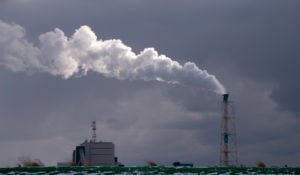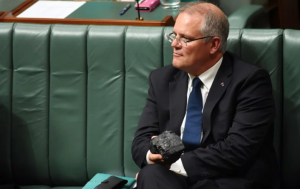As record temperatures have baked the United States for two months, feverish, and often surreal battles over climate policy have broken out across the country.
While some states have put in place radical and ambitious new climate change laws and targets, others have given polluting power plants more money. The reaction from some opponents of climate action has reached ridiculous proportions, culminating in threats of violence.
Ohio protects polluters
In late July, Ohio passed a bill to rescue three coal and two nuclear plants using money intended for renewable energy and energy efficiency. This may increase Ohio’s greenhouse gas emissions relative to if the money had been used for its original purpose.
The struggle over climate policy in Ohio state mirrors that taking place at the national level. Many Ohio Republicans, much like President Trump, see a political advantage in supporting coal, despite the rapid, nationwide decline in coal use and the bankruptcy of many coal companies. Protecting old coal jobs seems a more powerful political force than creating new, green ones.
Incumbent industries helped create this policy through lobbying and political donations. First Energy Solutions, a company that will benefit from the bailout, lobbied both Ohio state and the Trump administration. The company is already bankrupt. Without support from the state it would likely cease to exist.
The bill will also make it easier for residents in parts of the state to block the construction of wind power projects.
Some Republicans are worried they are sending the wrong message to business and that the state will miss out on renewable energy investment, which has grown rapidly in neighbouring states. Senator Joe Uecker, a Republican, said: “Investments in Ohio will start disappearing faster than a snow cone in Phoenix.” Critics of the bill described it as the worst policy in the country. There is a real risk that other Republican-led states will follow Ohio’s lead.
New York mandates renewables
Hundreds of miles to the east, New York provides a different vision of the future. Home to around 20 million people and the financial capital of the world, what happens in New York matters far beyond state lines.
The election of a new wave of younger, more radical state Democrats has changed state politics. New York had a passable record on climate, but in recent weeks Governor Andrew Cuomo has signed into law the country’s most ambitious climate goals. These will cut greenhouse gas emissions 85% by 2050 and require utilities to source 70% of their energy from renewables by 2030. The new laws chime with the Green New Deal, promoted at the federal level by congressional Democrats like Alexandria Ocasio-Cortez, who also represents New York.
New York is the sixth state to mandate 100% renewable energy, following Hawaii, Nevada, New Mexico, Washington and California. Such action at the state-level is essential given the determination of the Trump administration to protect polluters.
But New York’s new laws will require renewable energy and infrastructure construction at a scale and pace never seen before. Many more people will need to use the city’s subways, trains and buses, but improving the transport system won’t come cheap in a city that has the highest subway construction costs in the world. The recently opened Second Avenue extension cost a whopping US$1.7 billion per kilometre. In Beijing, construction costs are about one tenth of New York, at US$150 million per kilometre. Local resistance by groups who oppose wind power also poses problems, especially as New York is targeting nine gigawatts of offshore capacity by 2035. These groups have concerns ranging from wind farms decreasing the value of their property, to noise pollution and turbines killing birds. Political opposition also plays a role, as renewable energy is associated by many people with the Democratic Party and there are many Republican voters in rural areas.
Climate deniers on the run
Over on the west coast, an astonishing spectacle unfolded in Oregon, where state Democrats attempted to pass a cap-and-trade scheme to reduce greenhouse gas emissions 80% by 2050. Rather than vote on a bill they disagreed with, Republican state senators literally ran away, leaving Democrats, who have a large majority, without the quorum necessary to pass legislation. Kate Brown, the Democratic governor of the state ordered police to round up the rogue Republicans but one of them, Brian Boquist, threatened retaliation, telling police to “send bachelors and come heavily armed”. Such bluster may sound incredible, but the state has a history of stand-offs with right-wing militias and the state capitol was subsequently closed because of “possible militia threats”.
Ultimately the Democrats backed down and delayed a vote on the legislation. Tera Hurst, executive director of Renew Oregon described it as “the biggest failure of public leadership in Oregon in recent memory”. The stand-off sends a worrying signal about the viability of future climate legislation. If policies can’t pass in Oregon, a state dominated by Democrats, what chance of more radical action ever passing at the federal level?
And what about Ohio? President Trump attempts to bail out the coal industry have failed so far, but that won’t matter if state-level bailouts succeed. On the other hand, if New York hits its climate targets, the knock-on effects would be profound, as other states would surely follow.
Given the size and strategic importance of the United States in responding to global climate change, it seems likely that representatives from Salem, Oregon and Cincinnati, Ohio will play a disproportionate role in determining all of our futures.








